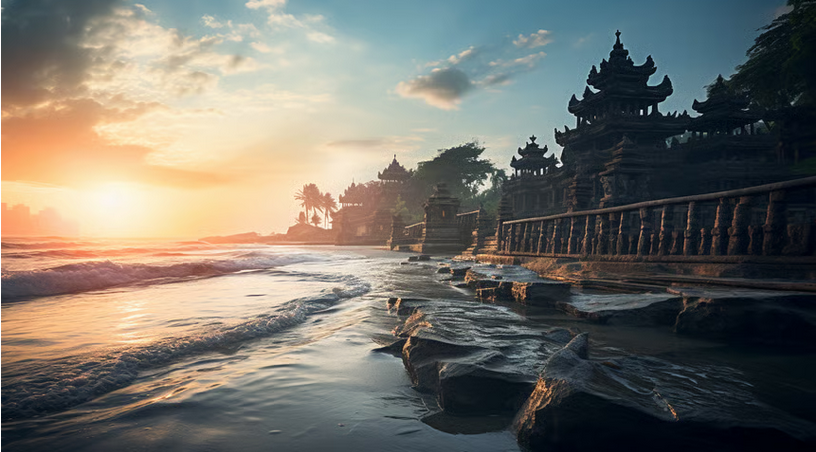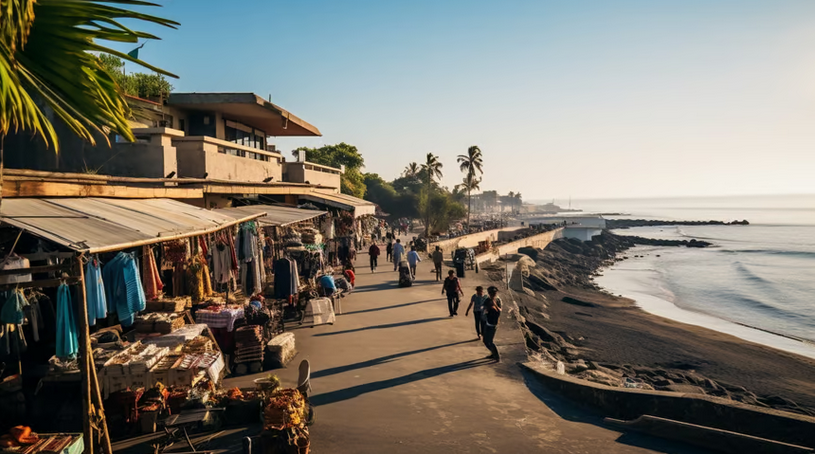Where Salt Meets Culture: The Rich Histories Behind Asia's Most Popular Beaches
Dive into Asia's most popular beaches, where the echoes of history ripple through the salt-sprayed air and every grain of sand tells a story of civilizations, conquests, and the timeless tides.
11/9/20239 min read

Ah, the allure of Asia's most popular beaches. These sun-kissed shores have beckoned travelers from far and wide for centuries, offering a unique blend of natural beauty and cultural significance. From the vibrant traditions that surround these sandy stretches to the impact of tourism on their delicate ecosystems, the stories behind Asia's beaches are as diverse as the continent itself. Come along as we dive into the rich histories that have shaped these coastal destinations.
Understanding the Significance of Beaches in Asian Culture
Beaches hold a special place in the hearts of Asians. They are not merely recreational spaces but are deeply intertwined with local traditions and beliefs. In many communities, beaches serve as sacred sites for religious ceremonies and offerings. For example, in Bali, Indonesia, locals gather along the shores to perform colorful rituals to appease the gods and ensure bountiful harvests. The Balinese people believe that the ocean is a source of life and prosperity, and by making offerings to the sea, they seek blessings for a fruitful future. These rituals are accompanied by traditional music and dance, creating a vibrant and spiritual atmosphere that resonates with the souls of the participants.
Similarly, in Chennai, India, thousands of people flock to the Marina Beach during the Tamil harvest festival of Pongal to offer prayers and celebrate the abundance of the sea. Pongal is a time of gratitude and thanksgiving, and the beach becomes a hub of joyous festivities. Families come together to build intricate sand sculptures, depicting scenes from ancient folklore and mythology. The beach is transformed into a canvas of creativity and imagination, showcasing the rich cultural heritage of the region. The aroma of freshly cooked delicacies fills the air, as people prepare traditional dishes using the freshly harvested crops. It is a time of unity and celebration, where the beach acts as a catalyst for community bonding and cultural preservation.
In addition to their religious significance, beaches also feature prominently in Asian folklore. Tales of mystical creatures and legendary battles are often associated with these coastal areas. In the Philippines, the enchanting story of the mermaid-like creatures known as "Siokoy" has captured the imaginations of generations living near the renowned Boracay Island. According to local legends, Siokoys are sea creatures with the ability to shape-shift into human form. They are believed to possess magical powers and are known for their mischievous nature. The tales of encounters with Siokoys have been passed down through generations, adding an air of mystery and excitement to the beach experience. Visitors to Boracay Island find themselves captivated by the possibility of catching a glimpse of these mythical beings, adding an extra layer of charm to the already mesmerizing beauty of Asia's shores.
Furthermore, beaches in Asia are not only significant for their cultural and mythical associations but also for their ecological importance. These coastal ecosystems are home to a diverse range of plant and animal species, many of which are unique to the region. The coral reefs that fringe the shores provide habitats for countless marine organisms, supporting the delicate balance of the underwater world. The beaches themselves act as nesting grounds for various species of sea turtles, who return year after year to lay their eggs in the warm sand. The conservation efforts undertaken by local communities and environmental organizations play a crucial role in preserving these fragile ecosystems, ensuring that future generations can continue to enjoy the wonders of Asia's beaches.
The Historical Evolution of Asia's Beaches
Asia's beaches have witnessed the ebb and flow of civilizations throughout history. Ancient settlements along the coastlines served as bustling hubs of trade and cultural exchange. From the bustling port city of Hoi An in Vietnam to the majestic ruins of Ayutthaya in Thailand, these remnants of ancient coastal civilizations offer glimpses into the past.
Take a journey back in time to the ancient city of Hoi An, Vietnam. Situated on the banks of the Thu Bon River, this once-thriving trading port was a melting pot of cultures. The streets were lined with merchants from China, Japan, and Europe, all seeking to exchange goods and ideas. As you stroll along the sandy beaches, imagine the bustling activity that once took place here. The sound of merchants haggling, the smell of exotic spices, and the sight of colorful sails dotting the horizon.
Continue your exploration of Asia's historical beaches with a visit to Ayutthaya, Thailand. Once the capital of the Kingdom of Siam, this UNESCO World Heritage site is home to magnificent temples and palaces. As you wander through the ancient ruins, you can almost hear the echoes of the past. Picture the grandeur of the royal court, the vibrant festivals that took place on the beaches, and the bustling markets where traders from all corners of the world converged.
As European colonial powers made their way to the shores of Asia, beaches became strategic points of contention. These colonial-era beaches, such as Vizag in India or Hua Hin in Thailand, have transformed into popular tourist destinations today, blending historical charm with modern comforts.
Let's delve into the history of Vizag, India. This coastal city was once a crucial trading post for the British East India Company. The pristine beaches that stretch along the Bay of Bengal were witness to the arrival of European ships laden with goods from distant lands. Today, Vizag's beaches offer a unique blend of colonial architecture, such as the iconic Dolphin's Nose lighthouse, and modern beach resorts that cater to tourists seeking relaxation and adventure.
Travel further south to Hua Hin, Thailand, and discover its colonial past. Originally a quiet fishing village, Hua Hin gained prominence when the Thai royal family built their summer residence here. The picturesque beaches, with their soft sands and crystal-clear waters, became a playground for the elite. Today, Hua Hin retains its regal charm, with elegant beachfront hotels, golf courses, and a vibrant night market where you can sample delicious local cuisine.
As you explore these colonial-era beaches, you can't help but be captivated by the layers of history that have shaped them. From ancient civilizations to colonial powers, Asia's beaches have been witness to the rise and fall of empires. So, whether you're seeking a glimpse into the past or simply looking to relax on pristine shores, Asia's beaches offer a unique blend of history and natural beauty.

The Cultural Diversity of Asia's Beaches
Asia's diverse cultures are beautifully reflected in the myriad beach traditions found across the continent. In Southeast Asia, where palm-fringed beaches and crystal-clear waters abound, each country boasts its own unique beach culture. From the vibrant beach parties of Thailand's Koh Phangan to the serene yoga retreats in Bali, visitors can experience a range of atmospheres.
In Southeast Asia, the beach culture is as vibrant and diverse as the region itself. Thailand's Koh Phangan, known for its full moon parties, is a haven for party-goers from around the world. The beach comes alive with pulsating music, colorful lights, and enthusiastic crowds dancing and celebrating until the early hours of the morning. The energetic atmosphere is infectious, and visitors can immerse themselves in the lively beach culture, enjoying the vibrant nightlife and making unforgettable memories.
On the other hand, Bali, Indonesia offers a different kind of beach experience. Known for its tranquil and spiritual ambiance, Bali's beaches are a sanctuary for relaxation and self-discovery. The island is dotted with yoga retreats where visitors can practice mindfulness and connect with their inner selves. The sound of crashing waves, the gentle sea breeze, and the lush greenery surrounding the beaches create a serene environment perfect for rejuvenation and reflection. Bali's beach culture embraces the concept of holistic well-being, offering visitors a chance to unwind and find inner peace.
In East Asia, beaches possess a more serene and contemplative atmosphere. The shores of Jeju Island in South Korea or Ishigaki Island in Japan offer opportunities for relaxation and reflection, where ancient rituals and respect for nature are deeply ingrained in the local beach culture.
Jeju Island, often referred to as the "Island of the Gods," is known for its volcanic landscapes and breathtaking beaches. The local beach culture on Jeju Island is deeply rooted in the island's rich history and mythology. Visitors can witness traditional ceremonies and rituals performed by locals, paying homage to the deities believed to protect the island. The beaches of Jeju Island serve as a sacred space where locals and visitors alike can connect with nature and experience a sense of spirituality.
Similarly, Ishigaki Island in Japan offers a unique beach experience deeply influenced by the island's indigenous culture. The local beach culture revolves around the concept of "Yunta," which means harmony with nature. Visitors can participate in traditional fishing practices, learn about the island's unique flora and fauna, and engage in cultural activities such as traditional dance and music performances. The beaches of Ishigaki Island provide a serene backdrop for immersing oneself in the island's rich cultural heritage.
The Impact of Tourism on Asia's Beaches
The influx of tourists to Asia's magnificent beaches has undoubtedly left its mark on these once-pristine ecosystems. Balancing the preservation of culture and the demands of tourism is a delicate dance. Governments and communities are working tirelessly to find sustainable solutions that ensure the economic benefits of beach tourism while safeguarding the fragile coastal environments.
Beach erosion and the threat of climate change pose significant challenges to the future of Asia's beaches. Rising sea levels and extreme weather events have already begun to reshape coastlines, exposing vulnerable communities to the full force of nature. Strategies for climate resilience and adaptation are essential to safeguard the cultural and ecological treasures that beaches represent.
One of the key issues that arise from the influx of tourists is the strain it puts on the local infrastructure. As more and more visitors flock to Asia's beaches, the demand for accommodation, transportation, and other amenities increases exponentially. This surge in demand often leads to the construction of new hotels, resorts, and other tourist facilities, which can have a detrimental impact on the natural beauty of the surrounding areas.
Furthermore, the increased human activity on the beaches can disrupt the delicate balance of the ecosystems. Tourists often leave behind litter and waste, which can harm marine life and pollute the water. The noise and disturbance caused by large crowds can also disrupt the natural behavior of animals, such as nesting sea turtles or migratory birds.
To mitigate these negative impacts, governments and local communities have implemented various measures. One approach is the establishment of marine protected areas, where certain areas of the beach and surrounding waters are designated as off-limits to tourists. These protected areas serve as sanctuaries for marine life, allowing them to thrive undisturbed.
Another strategy is the promotion of responsible tourism practices. This includes educating tourists about the importance of preserving the environment and encouraging them to minimize their ecological footprint. Many beach destinations now have programs in place to encourage visitors to participate in beach clean-ups and other conservation activities.
Additionally, efforts are being made to reduce the carbon footprint of beach tourism. This includes the use of renewable energy sources in hotels and resorts, as well as promoting sustainable transportation options such as electric vehicles or bicycles. By reducing greenhouse gas emissions, these initiatives contribute to the overall resilience of Asia's beaches in the face of climate change.
Despite the challenges, it is important to recognize the positive aspects of tourism on Asia's beaches. The economic benefits generated by tourism can contribute to the development of local communities, providing employment opportunities and improving infrastructure. Furthermore, tourism can foster cultural exchange and understanding, as visitors from different parts of the world come together to appreciate the beauty of Asia's beaches.
In conclusion, the impact of tourism on Asia's beaches is a complex issue that requires careful consideration and planning. While there are undoubtedly negative consequences, efforts are being made to mitigate these impacts and ensure the long-term sustainability of beach tourism. By finding a balance between economic development and environmental preservation, Asia's beaches can continue to captivate visitors while safeguarding their natural and cultural heritage.

The Future of Asia's Beaches
While the challenges ahead may seem daunting, there is reason for hope. Sustainable tourism practices, such as responsible waste management and eco-friendly accommodations, are gaining momentum, allowing visitors to enjoy the beauty of Asia's beaches while minimizing their impact.
As travelers, we have the power to make a difference. By choosing mindful tourism, supporting local communities, and respecting the delicate balance between culture and nature, we can help preserve the rich histories behind Asia's most popular beaches for future generations to experience and cherish.
Dive Deeper to Asia's Stunning Shorelines
Asia's beaches offer more than just sun, sand, and surf. They are living embodiments of centuries-old traditions, epic tales of folklore, and the ever-changing tides of history. As we explore these beautiful coastal landscapes, let us remember the importance of preserving this cultural heritage and natural wonders. Together, we can ensure that the beaches of Asia continue to captivate the world, for generations to come.